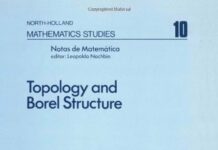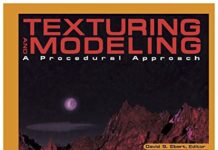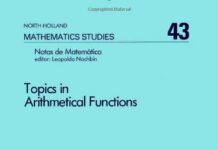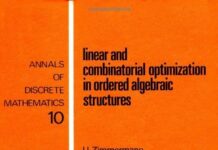
Ebook Info
- Published: 2011
- Number of pages: 93 pages
- Format: PDF
- File Size: 4.92 MB
- Authors: Author Unknown
Description
Spectral Theory and Complex Analysis
User’s Reviews
Reviews from Amazon users which were colected at the time this book was published on the website:
⭐The theory of several complex variables is very different from that of one variable, and many of the techniques used to study complex functions of several variables involve some fairly sophisticated tools from functional analysis and even algebraic topology. One of the main results in this area is the Oka-Weil theorem, which allows one to approximate a function holomorphic on a campact, polynomially convex set in complex n-space uniformly by polynomials. This result is an example of the ‘holomorphic functional calculus’ in the theory of Banach algebras. The condition of polynomial convexity in the Oka-Weil theorem is the starting point for the author, for the holomorphic functional calculus works when only convexity is assumed for the compact set. He wants to get away from the dependence on Banach algebras by considering approximators that satisfy certain growth conditions. The strategy he uses consists of the spectral theory of (Waelbroeck) b-algebras, which is the topic of this book. Chapter 1 considers the algebra of ‘tempered functions’ with respect to a ‘weight function’, along with the subalgebra of holomorphic functions of this algebra. Examples of this algebra include polynomials, entire functions of exponential type, and holomorphic functions with polynomial growth on an open set. A weight function d on complex n-space is a non-negative function that is O(1/|z|) at infinity and satisfies a Lipschitz condition. The author gives conditions for non-negative functions to be equivalent to weight functions. He also characterizes the algebras of holomorphic functions which are inductive limits of the algebra of tempered functions. For a directed set of weight functions, the author gives examples of these algebras on this directed set. In chapter 2, the author shows how to cover the tempered and holomorphic algebras with a covering of ‘pseudonormed’ vector spaces. Such a covering does not give a topology but does allow the desired approximation theory. The algebras then become examples of ‘polynormed vector spaces’, which are complex vector spaces equipped with a covering of pseudonormed spaces. If each member of the covering is a Banach space then the polynormed space is called complete. The tempered and holomorphic algebras are shown to be complete. Certain special polynormed vector spaces called polynormed algebras are then defined, which are such that the operation of multiplication is a bounded linear mapping. In such structures the product of two bounded sets is bounded, and this called an ‘algebra boundedness’. A ‘b-algebra’ is an algebra with a complete algebra boundedness. The author shows to what degree one can emulate the situation in commutative Banach algebras, namely, remembering that an ideal cannot contain the identity element, the ideal is the whole algebra if the unit is the limit of a sequence of elements in the ideal. The spectral theory of b-algebras is considered in chapter 3, with the author first reviewing the situation in Banach algebras. The spectra of elements of a b-algebra is not compact, and so the study of the resolvent function cannot necessarily be done on the complement of the spectrum. This motivates the author to define the spectral set of an element of a b-algebra as a condition on the boundedness of the resolvent over the complement of the element. Noting then that the study of entire functions cannot be done using spectral sets, the author defines a ‘spectral function’ as a refinement of a spectral set, and using this he constructs a holomorphic functional calculus. This involves proving that every spectral function is larger than some spectral function which is a weight function. After a review of the theory of plurisubharmonic functions, the author considers the spectral theory of O(d), where d is a weight function in chapter 4. The set G on which d is nonzero is shown to be a spectral set if and only if it is pseudoconvex. The author first considers spectral functions for z in O(d) where -log(d) is plursisubharmonic, and then studies the general case via a process of plurisubharmonic regularization of weight functions. He also proves the existence of a holomorphic function with polynomial growth on every pseudoconvex domain. This function cannot be holomorphically continued beyond this domain, called a ‘domain of holomorphy’. Chapter 5 considers a ‘spectral decomposition’ for holomorphic functions. A generalization of the usual theory, the author proves the decomposition property for O(d), a subalgebra of O(d), and inductive limits of these algebras. Ideals of holomorphic functions are studied and a theorem of Hormander, which gives a necessary and sufficient condition for this ideal to be all of O(d), is proven. The author returns to approximation theory in chapter 6. The Oka-Weil theorem, which gives conditions on which a holomorphic function can be uniformly approximated by polynomials is proven using the holomorphic functional calculus. The author then defines Runge domains and pairs and then considers approximation with growth. The author gives conditions guaranteeing that the polynomials are dense in O(d). The last chapter refines the results in chapter 6 by viewing O(d) as a ‘polynormed’ algebra, namely as a filtration of Banach spaces. A filtrated b-algebra is defined, and the author proves a spectral theorem for a commutative filtrated b-algebra. He applies these results toplurisubharmonic functions. Lastly, he chooses a weight function and defines what it means for an open subset of complex n-space to be polynomially convex with respect to this weight function, and proves that every polynomially compact subset of complex n-space has a fundamental system of neighborhoods composed of polynomially convex open sets.
⭐
Keywords
Free Download Spectral Theory and Complex Analysis (ISSN Book 4) in PDF format
Spectral Theory and Complex Analysis (ISSN Book 4) PDF Free Download
Download Spectral Theory and Complex Analysis (ISSN Book 4) 2011 PDF Free
Spectral Theory and Complex Analysis (ISSN Book 4) 2011 PDF Free Download
Download Spectral Theory and Complex Analysis (ISSN Book 4) PDF
Free Download Ebook Spectral Theory and Complex Analysis (ISSN Book 4)





